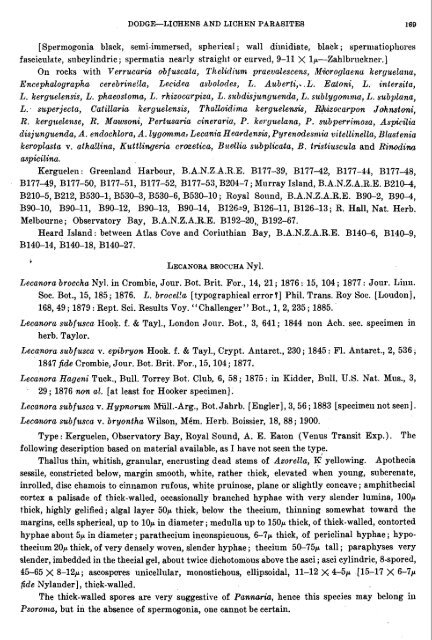Create successful ePaper yourself
Turn your PDF publications into a flip-book with our unique Google optimized e-Paper software.
DODGF-<strong><strong>LICHEN</strong>S</strong> <strong>AND</strong> <strong>LICHEN</strong> <strong>PARASITES</strong> 169<br />
[Spermogonia black, semi-immersed, spherical; wall diinidiate, blaclr; sperniatiopliores<br />
fasciculate, subcylindric; spermatia nearly straight or curved, 9-11 X lP-Zahlbruclrnel-.]<br />
On roclrs with VerruccLria obfuseatu, Tkeliditcnt praevalescens, A"iicrog1aencL kerguelana,<br />
EncephaJographas cerebrine!la, Lecidea asbolodes, L. Auberti,..L. Eatoni, L. intersita,<br />
L. kergtl.elensis, L. phaeostoma, L. rhizocarpiza, L. szcbdisjunguenak, L. sublyg@ntnta, I,. subplana,<br />
L. superjecta, Catillaria8 kerguelensis, ThaEhidima kerguelewis, IWtizocarpon Johnstmi,<br />
R. kergtcelense, R. Mawsoni, Pertusaria cineraria. P. kerguelana, P. szhbperrimosa, Aspicilia<br />
disjungtcenda, A. endochlora, A. lygomma, Lecania Heardensis, Pyrenodesntia vitellinella, Blastenia<br />
keroplasta v. athallina, Kuttlingeria crmetica, BtieQiu subplicada, B. tn'stiuscula and Rimdim<br />
a~picilina.<br />
Kerguelen: Greenland Harbour, B.A.N.ZA.R.E. B177-39, Bl'i742, B177-44, B17748,<br />
B17749, B177-50, B177-51, B177-52, B177-53, B204-7 ; Murray Island, B.A.N.Z.A.R.E. B2104,<br />
B210-5, B212, B530-1, B530-3, B530-6, B530-10 ; Royal Sound, B.A.N.Z.A.R.E. B90-2, B904,<br />
B90-10, B90-11, B90-12, B90-13, B90-14, B12f~9, B126-11, B126-13; R. Hall, Nat. Herb.<br />
Melbourne; Observatory Bay, B.A.N.Z.A.R.E. B192-20,, B192-67.<br />
Heard Island: between Atlas Cove and Coriiithian Bay, B.A.N.Z.A.R.E. B140-6, B140-9,<br />
B140-14, B140-18, B140-27.<br />
i<br />
LECANORA BROCCHA Nyl.<br />
Lecanora broccha Nyl. in Crombie, Jour. Rot. Brit. For., 14, 21 ; 1876 : 15, 104 ; 1877 : Jour. Linn.<br />
Soc. Bot., 15, 185 ; 1876. L. brocel!a8 [typographical error PI Phil. Trans. Roy Soc. [Loadon],<br />
168,49; 1879 : Rept. Sci. Results Voy. "Challenger" Bot., 1, 2, 235 ; 1885.<br />
Lecanora subfusca Hoolr. f. & Tayl., London Jour. Bot., 3, 641; 1844 non Ach. sec. specimen in<br />
herb. Taylor.<br />
Lecanora slcbfusca v. epibryon Hook. f. & Tayl., Crypt. Antarct., 230; 1845: F1. Antarct., 2, 536;<br />
1847 fide Crombie, Jour. Bot. Brit. For., 15,104; 1877.<br />
Lecanora Hageni Tuclr., Bull. Torrey Bot. Club, 6, 58; 1875: in Kidder, Bull. U.S. Nat. Mus., 3,<br />
29 ; 1876 non a.l. [at least for Hooker specimen].<br />
Lecanora subfusca v. Hypnorum hfiil1.-Arg., Rot. Jahrb. [Engler], 3,56 ; 1883 [specimen not seen].<br />
Leca?zora subfusca v. bryontha Wilson, M6n1. Herb. Boissier, 18, 88; 1900.<br />
Type: Kerguelen, Observatory Bay, Royal Sound, A. E. Eaton (Venus Transit Exp.). The<br />
following description based on material available, as I have not seen the type.<br />
Thallus thin, whitish, granular, encrusting dead stems of Azorella, E yellowing. Apothecia<br />
sessile, coilstricted below, margin smooth, white, rather thick, elevated when young, subcrenate,<br />
inrolled, disc chamois to cinnamon rufous, white pruinose, plane or slightly concave ; amphithecial<br />
cortex a palisade of thick-walled, occasionully branched hyphae with very slender lumina, lOOp<br />
thick, highly gelified; algal layer 50p thick, below the thecium, thinning somewhat toward the<br />
margins, cells spherical, up to lop in diameter ; medulla up to 150~ thick, of thick-walled, contorted<br />
hyphae about 5~ in diameter ; parathecium inconspicuous, 6-7p thick, of periclinal hyphae ; hypothecium<br />
20~ thick, of very densely woven, slender hyphae ; thecium 50-75p tall ; paraphyses very<br />
slender, imbedded in the thecial gel, about twice dichotomous above the asci ; asci cylindric, 8-spored,<br />
45-65 X 8-12p ; ascospures unicellular, monostichous, ellipsoidal, 11-12 X 4-5p [15-17 X 6-7p<br />
fide Nylander] , thick-walled.<br />
The thick-walled spores are very suggestive of Pannaria, hence this species may belong in<br />
Psoronza, but in the absence of spermogonia, one cannot be certain.

















